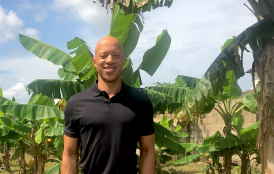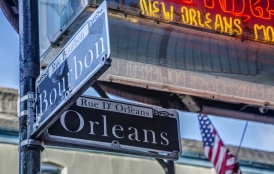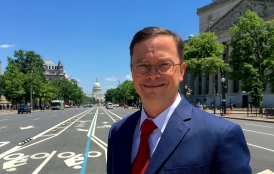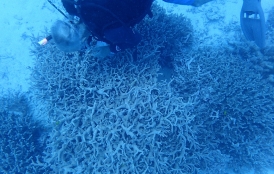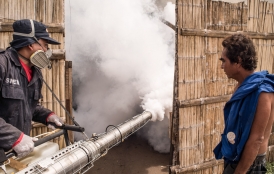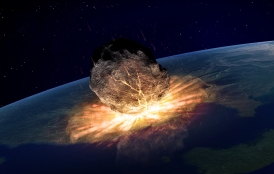The Stanford School of Earth, Energy & Environmental Sciences is now part of the Stanford Doerr School of Sustainability.
This page is currently being maintained for archival purposes only. For the latest information, please visit us here.
This geophysicist grew up in a crater. Literally.
For Tiziana Vanorio, an unsettling childhood experience in Italy evoked a curiosity that laid the foundation for a lifelong fascination with rocks.
By
Ker Than
February 25, 2014
Rona Chan
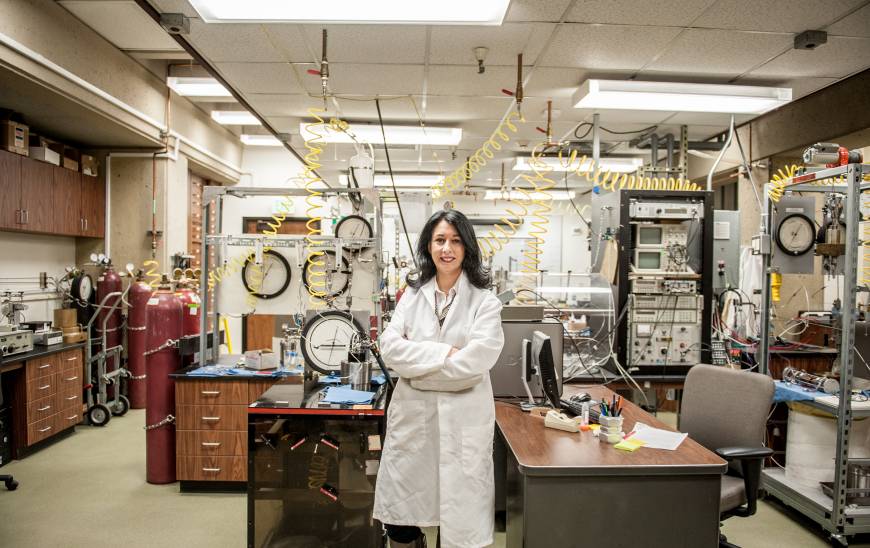
<p>Tiziana Vanorio in her lab. Credit: Rona Chan</p>
In 1999, Tiziana Vanorio arrived at San Francisco International Airport from Italy, excited to begin a six-month postdoc at Stanford University. But first she, and her precious cargo, had to pass through customs. "The customs agent asked me what was in my suitcase, and I said rocks," Vanorio recalled. "He said, 'rocks?'"
Packed carefully in Vanorio's suitcase were 60 plastic vials containing one-inch rock core samples, many of which she had painstakingly gathered herself from the region around her Italian hometown of Pozzuoli. Vanorio had ferried the samples across an ocean and a continent in order to analyze them using sophisticated instruments that could replicate the incredible pressures of the Earth's deep interior that were available in the lab of Professor Amos Nur, who at the time directed the experimental geophysics program at Stanford and is now emeritus faculty.
Vanorio eventually passed through customs, and her six months at Stanford turned into two years. "That was really a great time of growth, both scientifically as well as personally," Vanorio said. She later spent time as a researcher at the University of Nice in France, but in 2008 returned to Stanford as a senior researcher. In August of 2013, Vanorio was promoted to assistant professor of geophysics in the School of Earth Sciences.
An early interest in volcanology
Vanorio is an expert in using lab techniques to model the mechanical and chemical changes that rocks in the Earth’s interior undergo in the presence of pressurized, high-temperature fluids and gases. She traces her fascination with rocks to an experience that occurred while she was growing up in Pozzuoli.
An ancient port city located east of Naples, Pozzuoli is nestled in the center of a giant volcanic crater, or caldera, known as Campi Flegrei. The heat from shifting magma beneath Campi Flegrei leads to the formation of geysers, gurgling mud pools, and the famous hot springs for which Pozzuoli is known. The Romans believed that a volcanic crater lake near the town, Lago d'Averno, was one of the legendary entrances to Hades.
In 1983, when Vanorio was a teenager, Pozzuoli was racked by thousands of "microearthquakes". The tremors were small—most were below magnitude 4—but they were continuous. Combined with a worrisome swelling of the ground around the town, which scientists think was due to pressure exerted by a magma chamber or hydrothermal reservoirs, officials feared that a volcanic eruption might be imminent and ordered an evacuation of nearly half of the inhabitants. Vanorio was one of about 40,000 people forced to flee Pozzuoli and settle in towns scattered between Naples and Rome. "Pozzuoli became a ghost town because nobody could live there," Vanorio said.
Residents were allowed to return to Pozzuoli two years later after the shaking stopped and the ground swelling subsided. The experience left an impression on the young Vanorio, and as a result her academic interests shifted from a study of the classics—including Latin, Greek, and philosophy—to volcanology.
"I was curious about the phenomenon as a whole, and began to ask questions like why didn't the eruption occur? And how are evacuation decisions made?" Vanorio said. "When it was time to go to college, I knew that I wanted to study something related to Earth sciences."
After receiving her PhD in geophysics and volcanology from the University of Naples, Vanorio returned to Pozzuoli realizing that her hometown was one of the best places in the world to study the geophysical response of rocks that were pressurized by water and gas, an area of research that at the time was still not very well understood.
Vanorio collected different types of volcanic rocks from around the Campi Flegrei with the goal of studying their behavior while exposing them to the same fluids and pressures present beneath the caldera. There was a problem, however. The University of Naples lacked instruments that could replicate the immense pressures found deep inside the Earth.
So Vanorio searched abroad, and discovered that Stanford University had the type of instruments she needed. A few months later, Vanorio was on a plane headed for San Francisco. “It was my first time in the United States, and I came with rocks,” she said, laughing at the memory.
Chemical and physical interactions in rocks
Today, Vanorio's research continues to involve studying rocks under pressure and extreme temperatures, but she has expanded to investigate the mechanical and chemical, or "chemo-mechanical," interactions that rocks undergo in the presence of high-temperature and pressurized gas and fluids. "Many rocks have fluids in them," Vanorio said. "The fluids interact with the grains that constitute the rocks and changes them. That part isn't included in the rock physics models that we use today."
A chemo-mechanical rock model could lead to a better understanding of volcanic landscapes such as Campi Flegeri, but it also has implications for some proposed solutions to climate change, Vanorio said. For example, one idea for reducing atmospheric greenhouse gas is to sequester carbon dioxide in porous rocks found in abandoned mines, depleted reservoirs, and saline aquifers. “This approach may induce strong thermo-chemo-mechanical disequilibria, which are overlooked by our current rock physics models,” Vanorio said.
A chemo-mechanical approach is also key to understanding the geophysical response of shale deposits that are mature enough for drilling to extract oil or natural gas, she added.
Vanorio currently teaches classes at Stanford about the water-energy nexus and geophysics laboratory methods. Using a seed grant from Vice Provost for Online Learning (VPOL) and the School of Earth Sciences, Vanorio recently devised a project to create a series of computer tutorials aimed at speeding up student comprehension of basic concepts in experimental geophysics and teach them how to safely operate lab equipment by training them on virtual copies of complex scientific instruments like the ones that first drew her to Stanford all those years ago.
"I've never been disappointed by the facilities offered by Stanford," Vanorio said. "If I read in the paper that there's a new instrument that I can use in my research, it’s a good bet that someone at Stanford already has it."
Ker Than is the associate director of communications for the School of Earth Sciences


